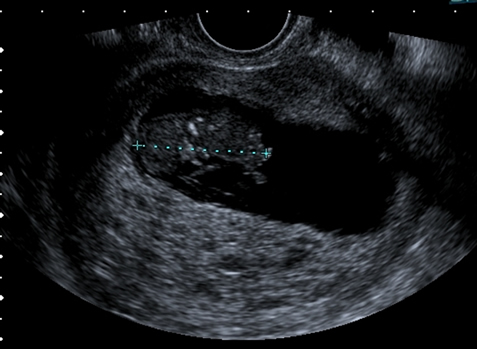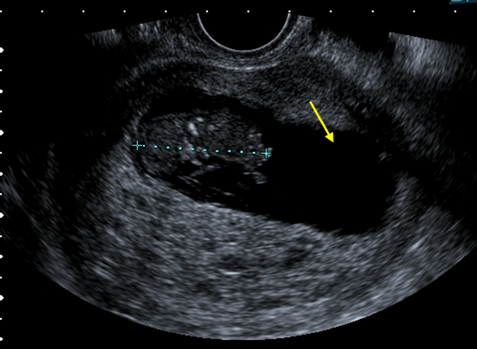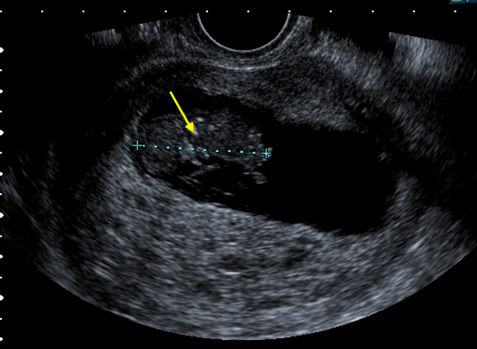Click on the links below.
Some pregnancies do not develop normally. Although fertilised, the egg is abnormal and the embryo does not develop. Most of the time it is only the placenta or trophoblast that develops (complete molar pregnancy) but in a small percentage of cases an abnormal embryo also develops (partial mole).
Complete mole
This is an example of a complete mole. The uterus is enlarged and contains abnormal trophoblast. Look how there are multiple black spaces within the uterus. These are multiple abnormal fluid-filled structures that fill the uterus. Most molar pregnancies will miscarry but some will be retained. A very few will develop into a special kind of cancer called chorioncarcinoma. Early evacuation of the uterus may prevent the development of cancer.
It is very important to diagnose molar pregnancy.
Click on the links below.
Some pregnancies do not develop normally. Although fertilised, the egg is abnormal and the embryo does not develop. Most of the time it is only the placenta or trophoblast that develops (complete molar pregnancy) but in a small percentage of cases an abnormal embryo also develops (partial mole).
Partial mole
A partial mole is a particular type of molar pregnancy where the abnormal embryo develops as well as the abnormal trophoblast (placenta). Usually the size of the embryo does not match the expected dates and may die in the first or early second trimester.
In this image, the embryo was not alive (there was no heartbeat). See how the trophoblast shows a similar pattern of black or cystic spaces as in Fig 1, but there is also a gestation sac and an embryo.
Click on the links below.
Some pregnancies do not develop normally. Although fertilised, the egg is abnormal and the embryo does not develop. Most of the time it is only the placenta or trophoblast that develops (complete molar pregnancy) but in a small percentage of cases an abnormal embryo also develops (partial mole).
Partial mole
A partial mole is a particular type of molar pregnancy where the abnormal embryo develops as well as the abnormal trophoblast (placenta). Usually the size of the embryo does not match the expected dates and may die in the first or early second trimester.
In this image, the embryo was not alive (there was no heartbeat). See how the trophoblast shows a similar pattern of black or cystic spaces as in Fig 1, but there is also a gestation sac and an embryo.
Click on the links below.
Some pregnancies do not develop normally. Although fertilised, the egg is abnormal and the embryo does not develop. Most of the time it is only the placenta or trophoblast that develops (complete molar pregnancy) but in a small percentage of cases an abnormal embryo also develops (partial mole).
Partial mole
A partial mole is a particular type of molar pregnancy where the abnormal embryo develops as well as the abnormal trophoblast (placenta). Usually the size of the embryo does not match the expected dates and may die in the first or early second trimester.
In this image, the embryo was not alive (there was no heartbeat). See how the trophoblast shows a similar pattern of black or cystic spaces as in Fig 1, but there is also a gestation sac and an embryo.
Click on the links below.
Some pregnancies do not develop normally. Although fertilised, the egg is abnormal and the embryo does not develop. Most of the time it is only the placenta or trophoblast that develops (complete molar pregnancy) but in a small percentage of cases an abnormal embryo also develops (partial mole).
Partial mole
A partial mole is a particular type of molar pregnancy where the abnormal embryo develops as well as the abnormal trophoblast (placenta). Usually the size of the embryo does not match the expected dates and may die in the first or early second trimester.
In this image, the embryo was not alive (there was no heartbeat). See how the trophoblast shows a similar pattern of black or cystic spaces as in Fig 1, but there is also a gestation sac and an embryo.




